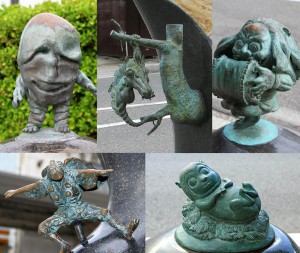
BY ALPER ÖZKAN (MSN/PhD)
d_ozkan@ug.bilkent.edu.tr
Mizuki Shigeru passed away last week, so I suppose at least some of you saw this column coming—leaving aside his substantial volume of nonfiction work (including “Onward Towards Our Noble Deaths,” a semi-autobiography about his experiences in World War II), the man’s influence on Japanese mythology is almost comparable to Tolkien’s influence on high fantasy, and just as modern notions of elves, dwarves, orcs and dragons largely follow the blueprint of Tolkien’s legendarium, Mizuki had a key role in shaping our views of the myriad strange creatures that populate Japan’s collection of folktales and urban legends. His characters are so beloved that there is an entire Mizuki Shigeru road, devoted to his life and chronicles of youkai (and especially to “GeGeGe no Kitaro,” his most famous work, which details the adventures of the titular, one-eyed goblin-boy), and so this is a good time to take a look at the mainstays of Japan’s supernatural scene.
 One fundamental premise of ghost stories is that strong emotions and worldly attachment can create a restless spirit, and things are no different in Japan: if you’re enraged beyond human capacity, or consumed by base urges like lust and hunger, you don’t even have to wait for death to become a monster. The story of Kiyohime, for example, tells of a woman being spurned by the monk she fell in love with, and growing so angry that she becomes a dragon, fiery breath and all (hell hath no fury, indeed). Such spirits are appeased with regular offerings even to this day, though perhaps the best way to deal with them is to prevent them from forming at all: Lafcadio Hearn relays the story of a criminal who is about to be put to the sword by a local lord, and threatens otherworldly vengeance in response: “You may well kill me,” says he, “but my spirit will surely haunt you for evermore!” The lord is not impressed—and why should he be, he says, his victim is a pathetic lowlife and surely can’t muster up the force of will to return from the grave. “I will believe you,” he declares, “only if your head can hang onto this rock after I behead you.” But the man does manage to clamp onto the rock with his teeth, terrifying the lord’s retainers—though not the lord, who assures his servants that the man, having fulfilled his last desire of biting onto that rock, has forgotten his actual grudge and will not return.
One fundamental premise of ghost stories is that strong emotions and worldly attachment can create a restless spirit, and things are no different in Japan: if you’re enraged beyond human capacity, or consumed by base urges like lust and hunger, you don’t even have to wait for death to become a monster. The story of Kiyohime, for example, tells of a woman being spurned by the monk she fell in love with, and growing so angry that she becomes a dragon, fiery breath and all (hell hath no fury, indeed). Such spirits are appeased with regular offerings even to this day, though perhaps the best way to deal with them is to prevent them from forming at all: Lafcadio Hearn relays the story of a criminal who is about to be put to the sword by a local lord, and threatens otherworldly vengeance in response: “You may well kill me,” says he, “but my spirit will surely haunt you for evermore!” The lord is not impressed—and why should he be, he says, his victim is a pathetic lowlife and surely can’t muster up the force of will to return from the grave. “I will believe you,” he declares, “only if your head can hang onto this rock after I behead you.” But the man does manage to clamp onto the rock with his teeth, terrifying the lord’s retainers—though not the lord, who assures his servants that the man, having fulfilled his last desire of biting onto that rock, has forgotten his actual grudge and will not return.
Shapeshifting animals are also a major feature, and indeed anything that gets old enough can become a minor spirit: though cats, foxes and raccoon dogs are the most famous, bats, weasels, badgers and even sugar gliders are also known to join in the fun. The definition of “fun” varies from tale to tale, and while most of these creatures are trickster spirits, one of my favorite stories is about a man becoming suspicious after learning that his grandmother has developed a taste for fresh liver and a penchant for coughing up hairballs, and ultimately discovering that the old woman’s cat had killed her and usurped her position. Another, more family-friendly favorite of mine is the story of Shojoji Temple, which was plagued by a pack of tanuki that infiltrated the monks’ quarters and drove them all out with their ruckus—all except one who, upon finding that the beasts were making music (by beating their bellies like a drum, as tanuki do), brought out his shamisen and started accompaying the lot. The situation quickly escalated into a “Devil Went Down to Georgia” scenario, and both the monk and the tanuki tried to outdo each other for days, but the critters ultimately lost after their leader exploded from overexerting himself (in a slightly different telling that I just came up with, the monk struck up a partnership with the tanuki and started a highly successful experimental rock band).
A third category of monsters is derived from neither human, nor beast, nor inanimate object—these are the “purest” class of spooks, representing hokey explanations for events with unknown causes, and Japan has an excellent selection of these, too. Nurikabe, a central character in Kitaro’s cast, is one such creature: manifesting as a normally invisible wall, it is essentially the Platonic form of getting lost in the mountains. Other youkai have far more obscure goals: the lobster-handed, scissor-headed spirit kamikiri exists only to suddenly cut people’s hair, while ashiarai yashiki is a giant, disembodied foot that crashes down from the sky into buildings and asks to be washed (bad things happen if you refuse). Still others exist as one-off excuses—a new legend was born, for example, when a samurai was questioned about why he decided to slash up a stone lantern, and managed to answer with a straight face that he had actually killed a monster that just happened to petrify after its death (or at least that’s the version I’m sticking to). It’s like coming up with the dog-ate-it excuse, having people believe it and somehow creating the story of an actual homework-eating dog, which really sounds like something Yo-kai Watch ought to feature.
This is of course only a glimpse of the diverse and bizarre cast of Japan’s folklore, and if you’re interested in more, there’s a vast amount of information out there on the Internet. Go forth and read!
